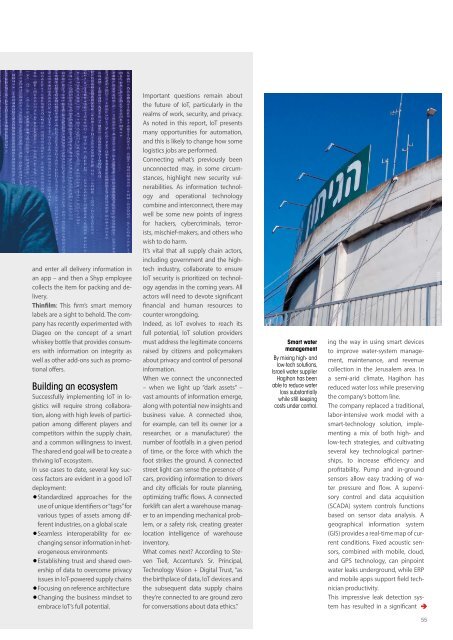Smart Industry 2/2018
Smart Industry 2/2018 - The IoT Business Magazine - powered by Avnet Silica
Smart Industry 2/2018 - The IoT Business Magazine - powered by Avnet Silica
You also want an ePaper? Increase the reach of your titles
YUMPU automatically turns print PDFs into web optimized ePapers that Google loves.
and enter all delivery information in<br />
an app – and then a Shyp employee<br />
collects the item for packing and delivery.<br />
Thinfilm: This firm’s smart memory<br />
labels are a sight to behold. The company<br />
has recently experimented with<br />
Diageo on the concept of a smart<br />
whiskey bottle that provides consumers<br />
with information on integrity as<br />
well as other add-ons such as promotional<br />
offers.<br />
Building an ecosystem<br />
Successfully implementing IoT in logistics<br />
will require strong collaboration,<br />
along with high levels of participation<br />
among different players and<br />
competitors within the supply chain,<br />
and a common willingness to invest.<br />
The shared end goal will be to create a<br />
thriving IoT ecosystem.<br />
In use cases to date, several key success<br />
factors are evident in a good IoT<br />
deployment:<br />
• Standardized approaches for the<br />
use of unique identifiers or “tags” for<br />
various types of assets among different<br />
industries, on a global scale<br />
• Seamless interoperability for exchanging<br />
sensor information in heterogeneous<br />
environments<br />
• Establishing trust and shared ownership<br />
of data to overcome privacy<br />
issues in IoT-powered supply chains<br />
• Focusing on reference architecture<br />
• Changing the business mindset to<br />
embrace IoT’s full potential.<br />
Important questions remain about<br />
the future of IoT, particularly in the<br />
realms of work, security, and privacy.<br />
As noted in this report, IoT presents<br />
many opportunities for automation,<br />
and this is likely to change how some<br />
logistics jobs are performed.<br />
Connecting what’s previously been<br />
unconnected may, in some circumstances,<br />
highlight new security vulnerabilities.<br />
As information technology<br />
and operational technology<br />
combine and interconnect, there may<br />
well be some new points of ingress<br />
for hackers, cybercriminals, terrorists,<br />
mischief-makers, and others who<br />
wish to do harm.<br />
It’s vital that all supply chain actors,<br />
including government and the hightech<br />
industry, collaborate to ensure<br />
IoT security is prioritized on technology<br />
agendas in the coming years. All<br />
actors will need to devote significant<br />
financial and human resources to<br />
counter wrongdoing.<br />
Indeed, as IoT evolves to reach its<br />
full potential, IoT solution providers<br />
must address the legitimate concerns<br />
raised by citizens and policymakers<br />
about privacy and control of personal<br />
information.<br />
When we connect the unconnected<br />
– when we light up “dark assets” –<br />
vast amounts of information emerge,<br />
along with potential new insights and<br />
business value. A connected shoe,<br />
for example, can tell its owner (or a<br />
researcher, or a manufacturer) the<br />
number of footfalls in a given period<br />
of time, or the force with which the<br />
foot strikes the ground. A connected<br />
street light can sense the presence of<br />
cars, providing information to drivers<br />
and city officials for route planning,<br />
optimizing traffic flows. A connected<br />
forklift can alert a warehouse manager<br />
to an impending mechanical problem,<br />
or a safety risk, creating greater<br />
location intelligence of warehouse<br />
inventory.<br />
What comes next? According to Steven<br />
Tiell, Accenture’s Sr. Principal,<br />
Technology Vision + Digital Trust, “as<br />
the birthplace of data, IoT devices and<br />
the subsequent data supply chains<br />
they’re connected to are ground zero<br />
for conversations about data ethics.”<br />
<strong>Smart</strong> water<br />
management<br />
By mixing high- and<br />
low-tech solutions,<br />
Israeli water supplier<br />
Hagihon has been<br />
able to reduce water<br />
loss substantially<br />
while still keeping<br />
costs under control.<br />
ing the way in using smart devices<br />
to improve water-system management,<br />
maintenance, and revenue<br />
collection in the Jerusalem area. In<br />
a semi-arid climate, Hagihon has<br />
reduced water loss while preserving<br />
the company’s bottom line.<br />
The company replaced a traditional,<br />
labor-intensive work model with a<br />
smart-technology solution, implementing<br />
a mix of both high- and<br />
low-tech strategies, and cultivating<br />
several key technological partnerships,<br />
to increase efficiency and<br />
profitability. Pump and in-ground<br />
sensors allow easy tracking of water<br />
pressure and flow. A supervisory<br />
control and data acquisition<br />
(SCADA) system controls functions<br />
based on sensor data analysis. A<br />
geographical information system<br />
(GIS) provides a real-time map of current<br />
conditions. Fixed acoustic sensors,<br />
combined with mobile, cloud,<br />
and GPS technology, can pinpoint<br />
water leaks underground, while ERP<br />
and mobile apps support field technician<br />
productivity.<br />
This impressive leak detection system<br />
has resulted in a significant<br />
photo ©: Hagihon Company Ltd.<br />
55
















